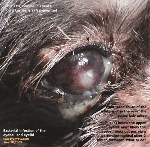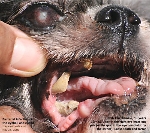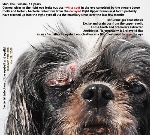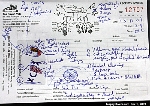Just give some eye-drops and
send the old Shih Tzu home with
antibiotics? This would probably
be the path taken by some vets.
This case needed more detailed
examination of the eye under
general anaesthesia.
"Will the old dog die under
general anaesthesia?" the couple
was worried as they must have
heard stories of dogs dying on
the operating table. The risks
are higher in old dogs. Old dogs
in poor health as in this case.
So, just give some eye-drops and
send the oldie home with
antibiotics? This will not
result in a satisfactory
outcome.
Surprisingly, this old dog does
not have heart disease. I gave
isoflurane general anaesthesia
by mask and intubate. It
was not possible to have a short
anaesthesia to minimise the risk
of death as the dog had bad
teeth. My hypothesis is that the
bacterial from the upper
premolar teeth had broken
through the sinus to the right
eye ball causing a bacterial
infection of the eyeball. The
dog rubs its eye and a white
patch appeared in the centre of
the eye. As it rubs frequently,
the white patch which used to be
a pigmented black area gets
injured. A hole of 2 mm in
diameter due to corneal rupture
appeared. From this hole, the
pus leaks out from inside the
eyeball. So, the young couple
sees a "white" spot appearing
every day. A leaking tap of pus
which is yellowish white.
In theory, the eyeball should be
enucleated or removed. But this
is a drastic surgery and
terribly emotional for the
couple. So, I removed pus from
the upper eyelid by excision and
draining the pus. Antibiotic eye
ointment and oral antibiotics
were given in addition to 3rd
eyelid surgery. I had the poor
dog's coat clipped short so that
it would feel comfortable. Will
this work?
3 days later, the couple came to
say that the dog was shivering.
"Is it eating and drinking
normally?" I asked. "No
problem." I palpated the
right eyeball. No pain.
"Clipped dogs may shiver," I
said. "Most likely, it is the
pain inside the eye." Hard to
tell what causes this shivering.
Could it be the effects of the
antibiotics?
I checked the mouth. "Very
clean," the young lady in her
mid 20s was quite happy with the
dental work. This would
probably be her companion when
she was growing up. I did not
ask her. And the man must be her
boyfriend or significant other
accompanying her to the vet? I
am glad that the butterfly of
love had not flitted away from
her as there are so many single
ladies in Singapore. I
must be equivalent to her old
dog in human age. Time had flown
by so fast for me since I
graduated.
I prescribed a brown sugar
multivitamin. 24 hours later, I
phoned the couple. There was
considerably less shivering. If
all goes well, the stitch in the
right eyelid would dissolve in
14-28 days and we would know
whether the right eyeball is OK.
This dog will live to old age of
15-20 years if it does not have
any infections. It
probably has grown up with the
young lady who probably has been
too busy studying.
On Dec 6, 2009, the dog came in
for stitch removal. The eyeball
looked all right. No more pus.
No more shivering except when
the dog came into the surgery.
The dog was as good as gold and
the couple was quite happy with
the outcome.
P.S.
An assistant must watch the
anaesthesia like a hawk
especially in an old dog surgery. In this
case, the dog's tongue turned
purplish during dental work even
though anaesthesia was at 1%
instead of the usual 2.0%. When
the tongue turns purplish, just
disconnect the tube from
the anaesthetic machine rather
than decreasing dose and
waiting.
This is the best method as the
old heart may be failing. When
the dog moves a bit and the
tongue turns pinkish,
re-connect.
Standby for cardiac massage.
Blow air into the lungs via the
tube after 3 massages. Repeat
till the dog breathes on its
own. Simple observations and
precautions prevent many
anaesthetic deaths in senior
dogs. Obviously, it was not
possible to just do the eye
operation and then the teeth
later to minimise the risk.
Sometimes, the owner just does
not return and the poor dog
still harbours the infectious
bacteria from gum and tooth
diseases in the mouth.
 TOA
PAYOH VETS
TOA
PAYOH VETS


